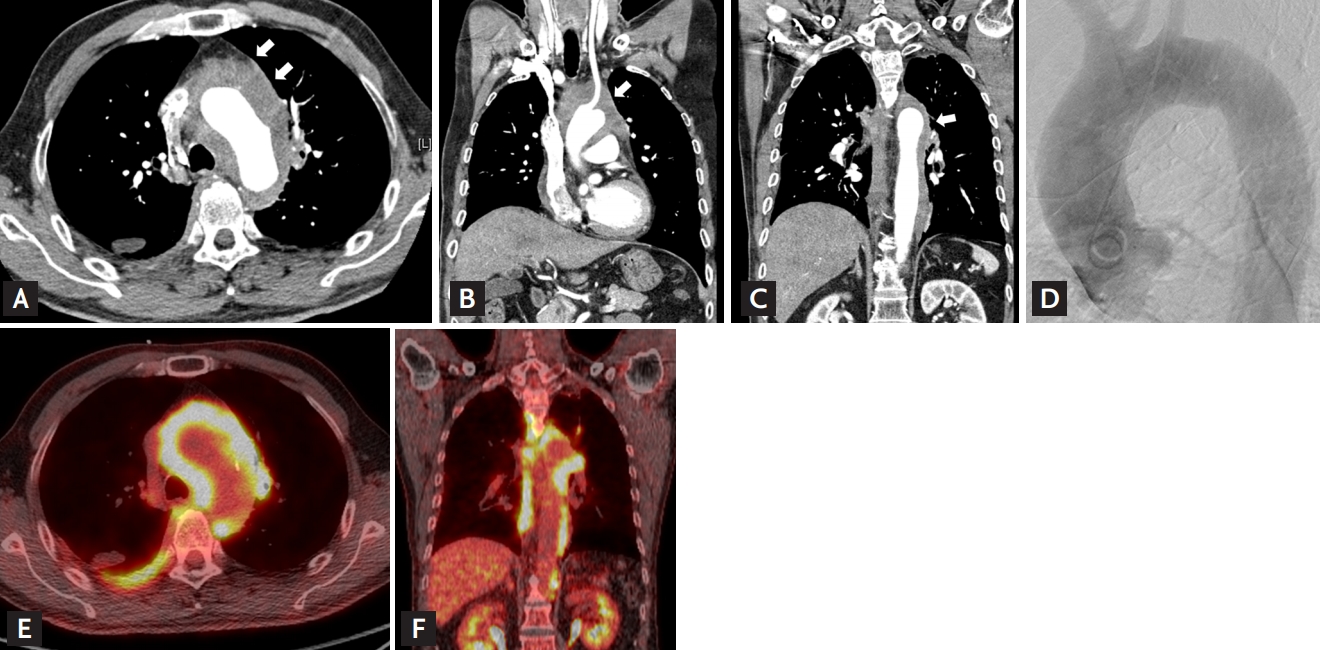A 68-year-old man was referred to our hospital owing to dyspnea and a low-attenuation mass-like lesion encasing the aortic arch extending to the descending thoracic aorta observed on chest computed tomography (CT) (Fig. 1A-1C).
He had experienced weight loss (5 kg) for 3 months. His initial vital signs were stable. The laboratory tests showed a normal complete blood count, elevated erythrocyte sedimentation rate (ESR; 120 mm/hr) and C-reactive protein (CRP) level (85 mg/L), and a normal procalcitonin level.
Transthoracic echocardiogram and coronary angiography, including an aortogram, revealed no specific dyspnea-related findings (Fig. 1D). Additional laboratory tests were conducted for the differential diagnosis of infective diseases, rheumatologic diseases, hematologic diseases, and other malignancies.
The patient tested negative for an interferon-gamma releasing assay and viral and rheumatoid markers. The serum immunoglobulin G (IgG) and IgG4 levels were elevated at 2,021 and 247 mg/dL, respectively.
Positron emission tomography showed intense fluorodeoxyglucose uptake in the mediastinal soft tissue infiltrative lesion (Fig. 1E and 1F). Incisional biopsy was performed (Fig. 2A and 2B). Pathological analysis revealed lymphoplasmacytic infiltration with fibrosis and an elevated IgG4 level (64 cells/high-power field) and IgG4/IgG ratio (82%), suggestive of IgG4-related periaortitis (Fig. 2C and 2D).
He was referred to the rheumatologic department; steroid treatment was initiated (prednisolone 20 mg twice daily). At the first follow-up visit, his dyspnea had markedly improved, and the serum ESR and the CRP and IgG4 (124 mg/dL) levels were normalized. Steroid therapy will be continued with follow-up CT after 3 months.
IgG4-related periaortitis is a rare autoimmune disease associated with systemic fibroinflammation. Early diagnosis using imaging modalities with histopathological confirmation is important to avoid irreversible organ damage requiring surgical or endovascular intervention, such as marked aneurysmal dilation or rupture of the aorta. This case suggests that IgG4-related periaortitis should be considered in patients with abnormal mass-like lesions surrounding the aorta.





 PDF Links
PDF Links PubReader
PubReader ePub Link
ePub Link Full text via DOI
Full text via DOI Download Citation
Download Citation Print
Print





